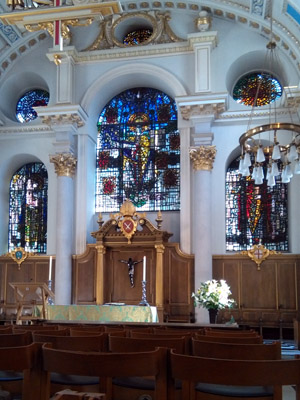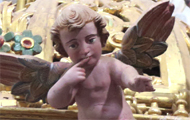| |
 |
 |
 |
| Comment on this report, or find other reports. |
 |
| Our Mystery Worshippers are volunteers who warm church pews for us around the world. If you'd like to become a Mystery Worshipper, start here. |
 |
| Find out how to reproduce this report in your church magazine or website. |
|
|
| 3074: St Mary le Bow, Cheapside, London |
 |

Photo:
© Steve Cadman and used under license
|
 |
Mystery Worshipper: The Citric Ascetic.
The church: St Mary le Bow, Cheapside, London.
Denomination: Church of England, Diocese of London.
The building: The current building is a reconstruction built after its predecessor was destroyed during the blitz of the Second World War. It was rebuilt to the design of Sir Christopher Wren, as the church was reconstructed following the Great Fire of London, almost exactly 350 years ago. Following Wren’s reconstruction, it was one of the tallest structures around (albeit still dwarfed by St Paul's cathedral a few yards away). Now, however, it is easy to walk past without noticing it, as the area has been developed by subsequent construction of offices.
As you enter the main body of the church, the first thing that strikes you is that it's nowhere near as big as you expect. The church is relatively wide, like a fairly grand church or cathedral, but the nave is severely stunted by comparison. What draws your eye are the stained glass windows behind the high altar. The eye is then drawn further up where a giant cross hangs over the heads of the congregation. Just behind the altar is a sort of crucifix statue, only there's no actual cross and the figure of Christ is represented by a dark, empty gown, making it rather resemble one of the dark non-beings called Dementors from the Harry Potter books.
The church: It is a rather odd church in that there are few (if any!) residential properties in the extremely small parish it serves. The high number of Anglican churches in the area means that each serves a very small territory. This, combined with the changing nature of the city, means that the church now only has services from Monday to Friday, with no regular weekend services, although the newsletter states that the church is "sometimes open on weekends and bank holidays." The area largely becomes a ghost town on weekends, populated only by tourists and the occasional protest march on the way to Westminster. As such the congregation, such as it is, is made up of transient workers who tend to worship elsewhere on a Sunday. The church is home to the famous "Bow Bells," which feature as the last of the church bells to be mentioned in the song "Oranges and lemons" and are also used as a means of defining who is a genuine Cockney (one who is born within the sound of Bow Bells).
The neighbourhood: St Mary le Bow sits near the heart of the Square Mile, London's financial district. It is situated roughly half way between St Paul's Cathedral and the Bank of England. As such, the church is something of an isolated, yet defiant, monument to the worship of God in the midst of an area devoted to the worship of mammon. One can step down just about any of the narrow side streets and discover pubs and restaurants that, though well hidden from view, are well known and well patronised by the local working populace.
The cast: The whole service was led by the Revd Michael Callaghan. One unnamed member of the congregation gave a reading.
The date & time: Friday, 23 September 2016, 1.05pm.
What was the name of the service?
Eucharist.
How full was the building?
Virtually empty. A few people came and went, but at no time did the congregation exceed the grand sum of ten people.
Did anyone welcome you personally?
No. The welcome was posted on the door, with a little notice that read: "Do come in, you are most welcome."
Was your pew comfortable?
Not especially. There were rows of wooden seats that were linked to one another, each with a thin leather cushion on them. There were some slightly sorry-looking kneelers on the back of each chair.
How would you describe the pre-service
atmosphere?
Quietly prayerful. The few of us there kept our heads bowed. No one spoke to one another. The only sound that marked the start of the service was the squeaking shoes of the Revd Michael Callaghan as he walked across the marble.
What were the exact opening words of the
service?
"In the name of the Father, and of the Son, and of the Holy Spirit."
What books did the congregation use during the
service?
Some people had a booklet with the liturgical script on it, though it wasn't clear where it came from. One person kindly gave me theirs, so I was eventually able to follow the service. There were no hymn books or pew Bibles visible.
What musical instruments were played?
There was no music in the service. So the large organ at the back of the church merely lurked silently.
Did anything distract you?
Outside the church is an open air cafe, and as the windows were open the sound of the bustling city seeped into the church. Also, half way through the service, someone came in and dropped some coins into a tin donation box, which made quite a clamourous sound.

Was the worship stiff-upper-lip, happy clappy, or
what?
This was at the fairly sombre end of Anglicanism. The celebrant was wearing a green and gold chasuble on top of a white alb. He (and several of the congregation) were very keen on crossing themselves repeatedly.
Exactly how long was the sermon?
3 minutes.
On a scale of 1-10, how good was the preacher?
4 – There was hardly enough time for a proper sermon. It was delivered clearly, but with no great depth.
In a nutshell, what was the sermon
about?
Based on Luke's account of Peter's confession of Jesus as Messiah (Luke 9:18-20), it was about the power of anonymity, with parallels being drawn between Jesus' need to keep his identity a secret and those of comic book superheroes. This was because had Jesus' identity as Messiah been revealed, it would have been like putting a lit match into dry tinder.
Which part of the service was like being in
heaven?
With so few people, the sharing of the peace allowed everyone to shake hands with everyone else. It was just a nice moment that we got to share in.
And which part was like being in... er... the other place?
When kneeling for communion, there was no cushion to kneel on, so we all knelt on a very hard marble step, which made for an added feeling of asceticism. It was quite an effort to be able to stand up again. Also during communion, the priest dropped a piece of the consecrated wafer and then accidentally stepped on it. While it momentarily stopped his shoes from squeaking, he then proceeded to eat the wafer he had trodden on. To some, treading on a communion wafer may cause a degree of consternation, though it was handled with minimal fuss.
What happened when you hung around after the service looking lost?
I sat in my seat for a few moments as some headed off (presumably back to their offices). One chap snuffed out the two candles on the altar. On my way out, I spoke briefly with the priest. I reflected on the idea of the power of anonymity as I dropped the Mystery Worshipper card into the donations box, and I then headed out from the quiet of the church into the hustle and bustle of London's financial district.
How would you describe the after-service
coffee?
There was no coffee on offer at the church, but there was no shortage of places nearby where one could grab a post-eucharistic dose of caffeine.
How would you feel about making this church your regular (where 10 = ecstatic, 0 = terminal)?
3 – Without a Sunday service it would be hard. But if I worked in the Square Mile, I'd be tempted to pop in every week or two.
Did the service make you feel glad to be a
Christian?
It left me feeling rather neutral. I wasn't glad to be a Christian, but nor was I embarrassed or upset.
What one thing will you remember about all this in seven days' time?
The marble floor's dual effects of making shoes squeak and knees ache. |
|
|
 |
 |
 |
| We rely on voluntary donations to stay online. If you're a regular visitor to Ship of Fools, please consider supporting us. |
 |
 |
 |
| The Mystery Pilgrim |
 |
| One of our most seasoned reporters makes the Camino pilgrimage to Santiago de Compostela in Spain. Read here. |
 |
 |
 |
| London churches |
 |
| Read reports from 70 London churches, visited by a small army of Mystery Worshippers on one single Sunday. Read here. |
| |
|
|
|
|


